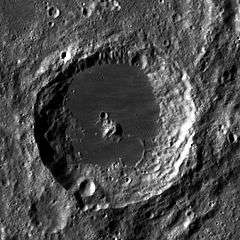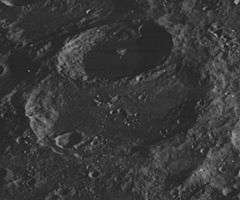Pauli (crater)
Pauli is a lunar impact crater that is located on the Moon's far side. It lies about halfway between the lunar equator and southern pole, across the southern rim of the larger walled plain Roche.
 LRO WAC image | |
| Coordinates | 44.5°S 137.5°E |
|---|---|
| Diameter | 84 km |
| Depth | Unknown |
| Colongitude | 224° at sunrise |
| Eponym | Wolfgang E. Pauli |

This crater has a well-defined outer rim that is only mildly worn by impact erosion. A small crater lies on the inner side along the south, and another on the opposite face of the crater to the north. There is some slight terracing along the southeast inner wall, but the remainder displays more of a radially grooved appearance. The inner wall is narrower along the northern side where it overlies Roche.
The interior floor has been flooded with lava, leaving a low-albedo surface that is darker than the surrounding terrain. In this respect it is similar to the crater Jules Verne located about four crater diameters to the northeast. There is a low ridge structure near the midpoint, and the remains of a ghost crater in the southeastern part of the floor.
Satellite craters
By convention these features are identified on lunar maps by placing the letter on the side of the crater midpoint that is closest to Pauli.
| Pauli | Latitude | Longitude | Diameter |
|---|---|---|---|
| E | 44.1° S | 141.4° E | 24 km |
References
- Andersson, L. E.; Whitaker, E. A. (1982). NASA Catalogue of Lunar Nomenclature. NASA RP-1097.CS1 maint: ref=harv (link)
- Blue, Jennifer (July 25, 2007). "Gazetteer of Planetary Nomenclature". USGS. Retrieved 2007-08-05.CS1 maint: ref=harv (link)
- Bussey, B.; Spudis, P. (2004). The Clementine Atlas of the Moon. New York: Cambridge University Press. ISBN 978-0-521-81528-4.CS1 maint: ref=harv (link)
- Cocks, Elijah E.; Cocks, Josiah C. (1995). Who's Who on the Moon: A Biographical Dictionary of Lunar Nomenclature. Tudor Publishers. ISBN 978-0-936389-27-1.CS1 maint: ref=harv (link)
- McDowell, Jonathan (July 15, 2007). "Lunar Nomenclature". Jonathan's Space Report. Retrieved 2007-10-24.CS1 maint: ref=harv (link)
- Menzel, D. H.; Minnaert, M.; Levin, B.; Dollfus, A.; Bell, B. (1971). "Report on Lunar Nomenclature by the Working Group of Commission 17 of the IAU". Space Science Reviews. 12 (2): 136–186. Bibcode:1971SSRv...12..136M. doi:10.1007/BF00171763.CS1 maint: ref=harv (link)
- Moore, Patrick (2001). On the Moon. Sterling Publishing Co. ISBN 978-0-304-35469-6.CS1 maint: ref=harv (link)
- Price, Fred W. (1988). The Moon Observer's Handbook. Cambridge University Press. ISBN 978-0-521-33500-3.CS1 maint: ref=harv (link)
- Rükl, Antonín (1990). Atlas of the Moon. Kalmbach Books. ISBN 978-0-913135-17-4.CS1 maint: ref=harv (link)
- Webb, Rev. T. W. (1962). Celestial Objects for Common Telescopes (6th revised ed.). Dover. ISBN 978-0-486-20917-3.CS1 maint: ref=harv (link)
- Whitaker, Ewen A. (1999). Mapping and Naming the Moon. Cambridge University Press. ISBN 978-0-521-62248-6.CS1 maint: ref=harv (link)
- Wlasuk, Peter T. (2000). Observing the Moon. Springer. ISBN 978-1-85233-193-1.CS1 maint: ref=harv (link)